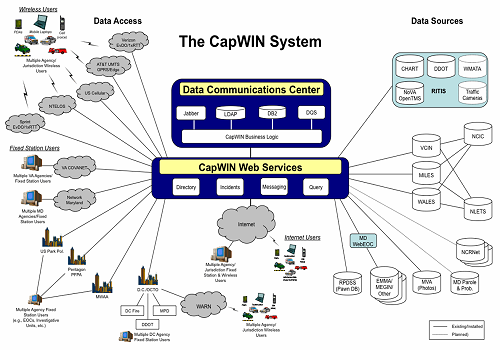TECHNOLOGY
System Summary
To advance its mission CapWIN has implemented an operating system that delivers data to personnel in the field across disciplines and agency boundaries. It has created a set of software Products and Services that supports field operations of law enforcement, fire/EMS, and transportation agencies. The CapWIN Software Solution Suite is a set of Government Off-the-Shelf (GOTS) standards-based solutions that gives users access to multiple data sources, for example, law enforcement systems (CJIS) in the three states, Maryland drivers license photos, and regional transportation incident data. Two mobile client applications—one for laptops and one for handheld devices—support field access to law enforcement and other data sources, secure instant messaging, and incident coordination tools. Finally, CapWIN staff provides operational support to participating agencies for pre-planned events, training services for users, and assistance with technology issues and system development.
CapWIN's technical infrastructure was designed by a coalition of representatives from public safety and transportation agencies across Maryland, Virginia and the District of Columbia. Based on national data exchange standards, the CapWIN system uses standard web services components that can be easily adapted to evolving mobile communication technologies, and to the requirements for compatibility with legacy agency infrastructures.
Following are key elements of the CapWIN design.
- Web Services based client and infrastructure designed for wireless environments (low and high bandwidth);
- Java/J2EE components running on high performance AIX and Linux servers;
- Jabber XMPP messaging supporting “push” technology;
- Custom software developed by the University of Maryland accesses multiple law enforcement databases and establishes FIPS 140-2 secure connections to field users;
- Database services uses DB/2 servers along with standard lightweight directory access protocol (LDAP) software;
- Dedicated connections and VPN’s connect to participating agency’s networks and wireless service providers;
- Redundant configurations ensure operations during hardware, software or power failure.
 |
CapWIN’s Mobile Clients are designed for maximum performance in wireless, field environments. By utilizing a web services-based interface, CapWIN Clients minimize bandwidth needs while maximizing field performance and capabilities. CapWIN Clients incorporate auto-updating capabilities, resulting in “zero touch” upgrades. CapWIN Clients enable:
- Local queuing of law enforcement queries – even in no-connectivity environments
- Persistent “store and forward” messaging – never miss an incident update or alert
- Local rendering of GIS maps supporting location-based services
- User-Customizable application and network linking
CapWIN’s data infrastructure also supports agencies using different mobile clients. For example, several jurisdictions in Maryland use CapWIN Web Services to access and deliver driver’s license photos to law enforcement officers in the field through their own mobile data client.
Development
CapWIN has established the CapWIN Agile Development Methodology (CADM) that provides the framework for all new software/system development work as well as ongoing tuning/maintenance. This iterative process ensures that new development is based on documented customer requirements. Constant customer feedback is received throughout the development lifecycle.
Standards
The design and development of the CapWIN system uses national “open” standards, wherever possible. Designed to enable data interoperability across multiple technical platforms, jurisdictions and public safety disciplines, CapWIN personnel participate in the implementation and development of new data exchange standards at the state, local and federal levels.
CapWIN continues to expand and demonstrate its use of specific XML Data Dictionaries and Data Models. Following are examples of some of the standards that have been utilized.
- National Information Exchange Model (NIEM);
- Global Justice XML Data Model (GJXDM);
- IEEE 1512 series of volumes pertaining to the Transportation Incident Management Message Sets;
- Organization for the Advancement of Structured Information Standards (OASIS) Common Alerting Protocol (CAP) and Emergency Data Exchange Language (EDXL);
- Various autonomous sensor protocols as deployed by the Public Safety, Public Health, Homeland Security, Transportation, and Disaster Management communities;
- Additional data models & dictionaries as they become available.

